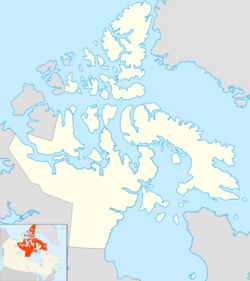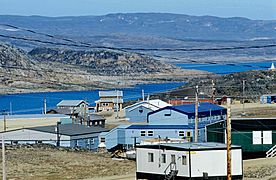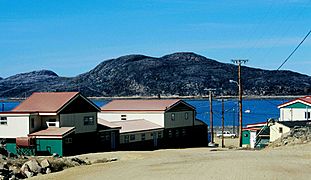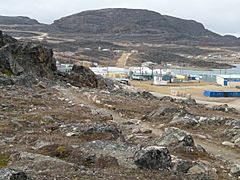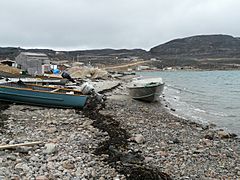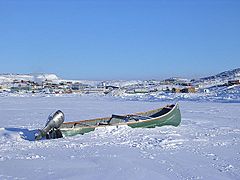Kinngait facts for kids
Quick facts for kids
Kinngait
Sikusiilaq
ᑭᙵᐃᑦ
|
|
|---|---|
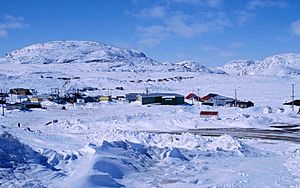
Part of the village with characteristic Kinngait hill,
May 1997 |
|
| Nickname(s):
Capital of Inuit Art
|
|
| Country | Canada |
| Territory | Nunavut |
| Region | Qikiqtaaluk |
| Electoral district | South Baffin |
| Federal Electoral district | Nunavut |
| Hudson's Bay Company post | 1913 |
| Government | |
| • Type | Hamlet |
| Area
(2021)
|
|
| • Total | 9.89 km2 (3.82 sq mi) |
| Elevation | 50 m (160 ft) |
| Highest elevation | 243 m (797 ft) |
| Lowest elevation | 0 m (0 ft) |
| Population
(2021)
|
|
| • Total | 1,396 |
| • Density | 141.2/km2 (366/sq mi) |
| Time zone | UTC−05:00 (EST) |
| • Summer (DST) | UTC−04:00 (EDT) |
| Postal code |
X0A 0C0
|
| Area code(s) | 867 |
Kinngait is an Inuit community in Nunavut, Canada. Its name means "high mountain" or "where the hills are" in Inuktitut. Until February 2020, it was known as Cape Dorset. Kinngait is located on Dorset Island, which is near the southern tip of Baffin Island. It is part of the Qikiqtaaluk Region.
Contents
History of Kinngait
Kinngait is a very old settlement. Scientists have found signs of ancient people here. These include the remains of the Thule people (who were early Inuit) and the pre-Inuit Dorset culture (also called Tuniit). These groups lived in the area between 1000 BCE and 1100 CE.
A European explorer, Captain Luke Foxe, named the area Cape Dorset in 1631. He named it after Edward Sackville, the 4th Earl of Dorset. The Inuit people already had a name for the nearby sea: Sikusiilaq. This name means "the area of sea ocean nearby that remains ice-free all winter."
In 1913, the Hudson's Bay Company set up a trading post in Kinngait. Here, people traded furs and animal skins for important supplies. These supplies included things like tobacco, ammunition, flour, and tea.
In 2019, the people of Cape Dorset voted to change the hamlet's official name back to its Inuktitut name, Kinngait. They chose between Kinngait, Sikusiilaq, and the English name Cape Dorset.
Art in Kinngait
Kinngait is famous for its art. It even calls itself the "Capital of Inuit Art." Since the 1950s, it has been a major center for drawing, printmaking, and carving. Today, making prints and carvings are still the main ways people earn money in the community. Every year, Kinngait Studios releases a new collection of prints. About 22% of the working people in Kinngait are artists, making it one of Canada's most artistic communities.
How Inuit Art Started Here
In 1957, a man named James Archibald Houston started a graphic arts workshop in Kinngait. This project was supported by the Canadian government. The idea was to help the community make money by using traditional art skills with new methods.
Houston collected drawings from local artists. He also encouraged Inuit stone carvers to try stone-block printing. This way, their art could be sold and shared more widely. The print program was inspired by Japanese ukiyo-e workshops. Other art workshops started in nearby communities, but the Kinngait workshop became the most successful.
Artists in Kinngait have tried many different printing methods. These include etching, engraving, lithography, and silkscreen. The workshop is known as the West Baffin Eskimo Cooperative, or the Kinngait Co-operative. They publish yearly catalogs to show their limited edition prints.
Famous Artists from Kinngait
Between 1959 and 1974, Kinngait artists created over 48,000 prints. Many artists from Kinngait are well-known. Some of them are Pitseolak Ashoona, Nuna Parr, Pudlo Pudlat, and Kenojuak Ashevak.
Nuna Parr's carvings are famous around the world. His work is shown in the National Gallery of Canada. Kenojuak Ashevak's drawings of owls have even appeared on Canadian stamps and a Canadian quarter coin.
Peter Pitseolak, an Inuit carver, artist, photographer, and writer, lived in Kinngait for many years. The local high school is named after him.
Below is a list of some artists from Kinngait:
- Kenojuak Ashevak
- Kiugak Ashoona
- Pitseolak Ashoona
- Shuvinai Ashoona
- Kingmeata Etidlooie
- Osuitok Ipeelee
- Siassie Kenneally
- Qaunaq Mikkigak
- Ohotaq Mikkigak
- Omalluq Oshutsiaq
- Eleeshushe Parr
- Parr
- Peter Pitseolak
- Tim Pitsiulak
- Annie Pootoogook
- Kananginak Pootoogook
- Napachie Pootoogook
- Mary Pudlat
- Pudlo Pudlat
- Lucy Qinnuayuak
- Simeonie Quppapik
- Pauta Saila
- Pitaloosie Saila
- Ningiukulu Teevee
- Ovilu Tunnillie
Population of Kinngait
| Federal census population history of Kinngait | ||
|---|---|---|
| Year | Pop. | ±% |
| 1976 | 688 | — |
| 1981 | 784 | +14.0% |
| 1986 | 872 | +11.2% |
| 1991 | 961 | +10.2% |
| 1996 | 1,118 | +16.3% |
| 2001 | 1,148 | +2.7% |
| 2006 | 1,236 | +7.7% |
| 2011 | 1,363 | +10.3% |
| 2016 | 1,441 | +5.7% |
| 2021 | 1,396 | −3.1% |
| Source: Statistics Canada |
||
In 2021, the population of Kinngait was 1,396 people. This was a small decrease from its population of 1,441 in 2016. The community has a land area of 9.89 square kilometers (about 3.8 square miles). This means there are about 141 people living in each square kilometer.
Getting Around in Kinngait
Kinngait has a few dirt and gravel roads. These roads are not paved because of the cold winter conditions. They do not connect Kinngait to other places. Cars and trucks are the main way people get around. In winter, people also use snowmobiles and ATVs (all-terrain vehicles).
When the Hudson Strait is not frozen, people use boats and ships to travel to and from Kinngait.
Air Travel
The Cape Dorset Airport serves the area. You can fly from Kinngait to other places within Nunavut. To travel outside Nunavut, you usually have to connect through Iqaluit Airport.
Education in Kinngait
Kinngait has two main schools. The Peter Pitseolak School (PPS) is the junior-senior high school. This school was unfortunately destroyed by a fire in 2015. However, in 2019, a new printmaking studio workshop opened at the school for children. This was part of the Embassy of Imagination program.
Sam Pudlat School is the community's only elementary school. It has about 227 students. Students usually attend elementary school well, but attendance can be lower at the high school.
For education after high school, there are some options at the Community Learning Centre in Kinngait. Nunavut Arctic College, which is based in Iqaluit, sometimes offers programs in Kinngait.
Community Services
Kinngait has several important community services.
Safety Services
The Royal Canadian Mounted Police (RCMP) has a police station in Kinngait. It is usually staffed by six to ten officers. The Fire Department has 25 volunteers and one fire truck. Because there are not many fire hydrants, the fire truck has to be filled with water at a special station.
Health Services
The Cape Dorset Health Centre provides basic medical care. For more serious medical problems, people need to be flown by air to the Qikiqtani General Hospital in Iqaluit. There is no ambulance in Kinngait, and doctors only visit sometimes. There is a taxi service, but it is not always available.
Internet and Communication
Kinngait has been connected to the Qiniq internet network since 2005. This network is managed by SSi Canada. In 2017, the network was updated to faster 4G LTE technology. It also offers 2G-GSM for mobile phone calls.
Housing in Kinngait
Like many places in Nunavut, houses in Kinngait can be very crowded. A report from 2006 showed that up to 12 people might live in a two-bedroom home. The Nunavut Housing Corporation plans to build five new housing units in Kinngait by late 2022 or early 2023 to help with this problem.
Food Costs
Basic food items like milk, cheese, flour, and butter cost much more in Kinngait than in cities like Ottawa or Montreal. They can be 65-75% more expensive. This makes it hard for some families to afford enough food. This problem is called food insecurity, and it affects Kinngait and other parts of Nunavut.
Tourism and Attractions
Kinngait offers interesting places to visit and things to do.
Mallikjuaq Territorial Park
Mallikjuaq Territorial Park covers both Dorset Island and Mallik Island. This park is special because it has many archaeological sites. These sites show the history of the Thule people, Dorset culture, and Inuit people. You can walk to the park from Kinngait when the tide is low, or you can go by boat.
RMS Nascopie Cairn
A stone monument, called a cairn, was built in memory of a ship named RMS Nascopie. This ship was a supply vessel for the Arctic. It hit a rock and sank in 1947. Even though the cargo was lost, all the passengers and crew were saved.
Kenojuak Cultural Centre
In September 2018, the Kenojuak Cultural Centre and Print Shop opened. This center is named after the famous local artist and Inuit art pioneer, Kenojuak Ashevak, who passed away in 2013. The center is a community building, an art studio, and a place to show art from local artists.
Tours and Activities
There are companies that offer tours in Kinngait. You can go dog sledding, camping, and hiking in the parks.
Gallery
Climate
Kinngait has a tundra climate. This means it has short, cool summers and long, very cold winters.
| Climate data for Kinngait (Cape Dorset Airport) WMO ID: 71910; coordinates 64°13′09″N 76°31′30″W / 64.21917°N 76.52500°W; elevation: 48.2 m (158 ft); 1991–2020 normals, extremes 1963–present |
|||||||||||||
|---|---|---|---|---|---|---|---|---|---|---|---|---|---|
| Month | Jan | Feb | Mar | Apr | May | Jun | Jul | Aug | Sep | Oct | Nov | Dec | Year |
| Record high humidex | 0.2 | 0.7 | 0.7 | 4.4 | 10.4 | 18.8 | 25.0 | 21.6 | 12.7 | 6.5 | 3.4 | 1.7 | 25.0 |
| Record high °C (°F) | 0.9 (33.6) |
1.9 (35.4) |
0.8 (33.4) |
5.6 (42.1) |
10.9 (51.6) |
19.7 (67.5) |
25.0 (77.0) |
21.9 (71.4) |
18.1 (64.6) |
7.1 (44.8) |
3.4 (38.1) |
2.2 (36.0) |
25.0 (77.0) |
| Mean daily maximum °C (°F) | −20.7 (−5.3) |
−21.6 (−6.9) |
−17.4 (0.7) |
−9.2 (15.4) |
−1.9 (28.6) |
5.7 (42.3) |
12.1 (53.8) |
9.9 (49.8) |
4.1 (39.4) |
−1.0 (30.2) |
−7.2 (19.0) |
−14.2 (6.4) |
−5.1 (22.8) |
| Daily mean °C (°F) | −23.7 (−10.7) |
−24.4 (−11.9) |
−20.7 (−5.3) |
−12.4 (9.7) |
−4.2 (24.4) |
2.9 (37.2) |
8.3 (46.9) |
6.8 (44.2) |
2.2 (36.0) |
−2.7 (27.1) |
−9.5 (14.9) |
−17.1 (1.2) |
−7.9 (17.8) |
| Mean daily minimum °C (°F) | −26.3 (−15.3) |
−27.1 (−16.8) |
−23.9 (−11.0) |
−15.5 (4.1) |
−6.4 (20.5) |
0.1 (32.2) |
4.5 (40.1) |
3.8 (38.8) |
0.1 (32.2) |
−4.4 (24.1) |
−12.0 (10.4) |
−19.8 (−3.6) |
−10.6 (12.9) |
| Record low °C (°F) | −38.9 (−38.0) |
−40.6 (−41.1) |
−42.2 (−44.0) |
−32.8 (−27.0) |
−19.6 (−3.3) |
−7.4 (18.7) |
−3.4 (25.9) |
−4.6 (23.7) |
−8.3 (17.1) |
−23.9 (−11.0) |
−30.6 (−23.1) |
−42.8 (−45.0) |
−42.8 (−45.0) |
| Record low wind chill | −54.5 | −58.1 | −53.0 | −44.6 | −29.3 | −14.6 | −7.0 | −8.7 | −14.7 | −39.7 | −40.1 | −51.4 | −58.1 |
| Average precipitation mm (inches) | 19.4 (0.76) |
17.2 (0.68) |
26.1 (1.03) |
25.8 (1.02) |
27.8 (1.09) |
33.3 (1.31) |
39.0 (1.54) |
57.3 (2.26) |
52.9 (2.08) |
48.0 (1.89) |
37.0 (1.46) |
29.6 (1.17) |
413.2 (16.27) |
| Average rainfall mm (inches) | 0.0 (0.0) |
0.0 (0.0) |
0.0 (0.0) |
0.3 (0.01) |
4.0 (0.16) |
20.9 (0.82) |
37.8 (1.49) |
52.1 (2.05) |
35.7 (1.41) |
7.2 (0.28) |
0.0 (0.0) |
0.0 (0.0) |
158.0 (6.22) |
| Average snowfall cm (inches) | 24.2 (9.5) |
24.2 (9.5) |
28.3 (11.1) |
32.8 (12.9) |
29.7 (11.7) |
8.5 (3.3) |
0.2 (0.1) |
1.2 (0.5) |
13.2 (5.2) |
40.1 (15.8) |
50.6 (19.9) |
37.6 (14.8) |
290.7 (114.4) |
| Average precipitation days (≥ 0.2 mm) | 15.2 | 13.0 | 15.7 | 14.0 | 12.7 | 10.1 | 11.1 | 13.0 | 15.7 | 17.5 | 19.0 | 18.2 | 175.1 |
| Average rainy days (≥ 0.2 mm) | 0.0 | 0.0 | 0.0 | 0.4 | 1.9 | 6.8 | 11.4 | 13.3 | 10.6 | 3.2 | 0.1 | 0.0 | 47.8 |
| Average snowy days (≥ 0.2 cm) | 16.0 | 14.5 | 15.3 | 14.4 | 14.6 | 4.8 | 0.1 | 0.4 | 6.9 | 17.8 | 19.8 | 19.0 | 143.6 |
| Average relative humidity (%) | 72.7 | 71.7 | 72.8 | 78.1 | 83.1 | 77.0 | 69.8 | 75.6 | 81.4 | 84.4 | 83.6 | 79.2 | 77.4 |
| Mean monthly sunshine hours | 7.6 | 72.5 | 172.6 | 215.7 | 157.0 | 220.1 | 274.1 | 187.3 | 87.4 | 45.2 | 17.6 | 0.0 | 1,457.2 |
| Percent possible sunshine | 4.5 | 30.3 | 47.5 | 47.8 | 27.5 | 35.1 | 44.9 | 36.8 | 22.2 | 14.9 | 9.0 | 0.0 | 26.7 |
| Source: Environment and Climate Change Canada (rain/rain days, snow/snow days 1981–2010) Canadian Climate Normals 1981–2010 | |||||||||||||
See also
 In Spanish: Cabo Dorset para niños
In Spanish: Cabo Dorset para niños


